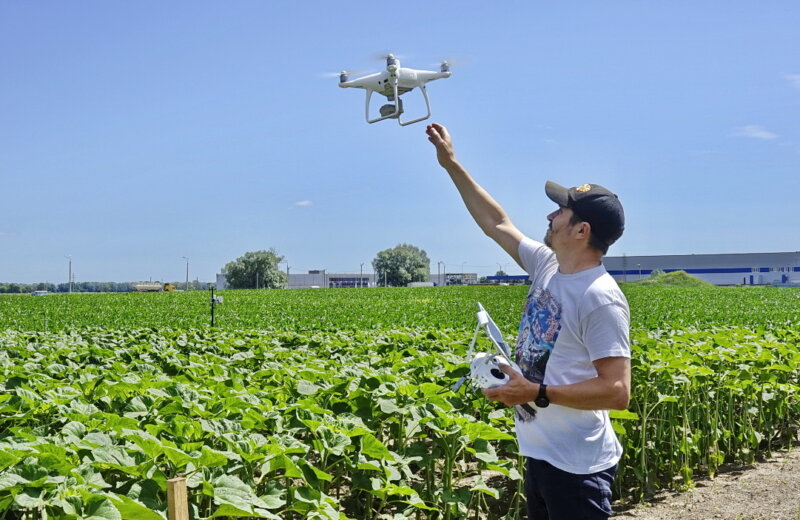It’s not an unusual sight now when a drone soars over Kyiv to take aerial shots of urban landscapes for business or for fun.
Drones have become so mainstream in recent years that even big firms have turned their eyes to the sky. Agricultural companies are among them.
Drones flying over the fields can see the exact size of the farmland and pinpoint spots where plants lack water, light or fertilizers. With this data, farmers can analyze what their crops require to give maximum yields.
Experts say that Ukraine is one of the most favorable markets in Europe to use agricultural drones, as the country barely regulates their use.
The size of the Ukrainian drone market reached $18 million in 2020 and is expected to grow to $36 million in 2021, according to Taras Troiak, founder of Quadro.ua, a company that sells drones by Chinese brand DJI.
But unlike in China or the United States, drones haven’t yet become popular with Ukrainian farmers — only 30% of the drone market relies on farmers. As the hardwave gets cheaper, more local entrepreneurs will step in to give their farms a high-tech boost, experts say.
‘Not a toy anymore’
Farmers usually choose between two types of drones: a multi-rotor drone, also called quadcopter, which is small and easy to use; and a fixed-wing drone, which looks like a small plane and can fly farther and faster on a single battery charge.
For farmers, quadcopters are more convenient — they can maneuver across fields and take off anywhere, according to Artem Belenkov, founder of Ukrainian company SmartFarming that helps agriculture firms adopt new technology.
Quadcopters are also cheaper than fixed-wing machines. A DJI quadcopter costs $10,400, while a fixed-wing drone by French manufacturer SenseFly goes for $15,800.
All drones have GPS, sensors and cameras that can detect problems that are otherwise hard to notice. Drones collect so much data that farmers often hire specialists to analyze it, using artificial intelligence and other software. They can even spot weeds or infected plants.
Some companies use drones to spray pesticides, fertilizers and water. It’s more precise and effective than doing it manually or using tractors that can harm crops and soil, according to Belenkov.
But a simple drone from an electronics store that isn’t equipped for the aforementioned services has no value to the farmer, said Valerii Iakovenko, founder of DroneUA, a Ukrainian company that sells drones and helps use them.
“Drone is just a piece of metal that costs nothing until it solves a problem,” Iakovenko said.
That’s why farmers often just rent the right drones, according to Yaroslav Movchun, co-owner of berry farm Ozeryana in Zhytomyr Oblast.
On his farm, Movchun uses a drone manufactured by Ukrainian company FlyingTractor. One unit sells for nearly $14,500.
The drone makes it easy for Movchun to fertilize the soil on time and with the right dose of chemicals — no traditional tractor can give the same precision.
“Drones are very convenient. It is a question of time when our farmers realize that is not a toy anymore,” Movchun told the Kyiv Post.
Foreign dominance
The Ukrainian drone market is ruled over by foreign behemoths like Chinese DJI and XAG.
According to Troiak, DJI controls 70% of the market. Most Ukrainians use drones for filmmaking or entertainment. About 30% of the drones DJI sells in Ukraine is used in industry; specific drones that spray fertilizers secure 15% of the company’s sales here.
Companies renting or selling drones usually import them because it’s hard to compete with well-established brands even when the price is right, according to Iakovenko.
When Iakovenko and his partner Fevzi Ametov entered the drone business in 2014, they built their own agricultural drone that cost $2,400 — nearly 10 times less than imported drones.
However, their startup couldn’t compete with well-marketed Chinese brands like DJI, so Iakovenko started importing drones, selling them in Ukraine and offering services like data analytics.
The company attracted clients from various industries, including energy, telecommunications and real estate. Agricultural giants Myronivsky Hliboproduct, Kernel, energy giant DTEK and mobile operator Vodafone are among its clients.
Big firms were the first to see the potential of using drones in Ukraine, Iakovenko said. But later on, small and medium-sized farms caught up and now they drive Ukraine’s drone market, as they’re faster to implement new tech.
Some farmers buy Ukrainian-made drones too, but according to Belenkov, Ukrainian manufacturers are dying out.
Ukraine ramped up drone production in 2014 when the war with Russia hit the eastern part of the country. Back then, they were mostly used as a military tool. But as firms like Ukrspecsystems started making drones for farmers, they lost the competition with foreign brands.
Soft regulation
Ukraine doesn’t regulate drones as strictly as Europe, but their owners still must follow some rules.
For example, drones cannot fly in certain regions of Ukraine like Crimea and the Donbas, which are occupied by Russia. The local government also wants to apply more restrictions to agricultural drones that spray pesticides and fertilizers in the fields, worrying that they can harm people’s health.
Overall, however, it’s more difficult to bring drones to Ukraine than to use them here, according to Iakovenko.
Given that many drones are big and some had previously been used for military purposes, firms like DroneUA need permits from Ukraine’s customs service to import them. Local authorities have to check whether drones can be used as a weapon, Iakovenko said.
It usually takes up to 30 days to get a permit and up to 45 days to check whether drones can work without interfering with other electronic devices.
“Drones are complicated cargo. Importing them is a challenge but we have to deal with it,” Iakovenko said. He thinks there’s no other way really if Ukrainian farmers want to stay competitive.
“Ukrainian farmers cannot work without drones now: they save time, they recognize problems, they help make decisions faster.”



